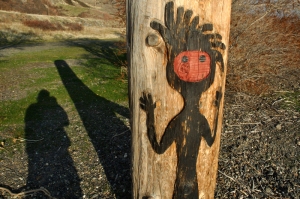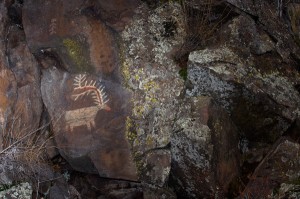The Voyage

Face to face with a freshly carved totem pole on the banks of the Columbia River. Copyright Mark B. Gibson
The Voyage begins
As a boy I loved reading about the history of my native state. The Dalles, my current home, was then on the “other” side of the mountains, where the familiar western rain forest shifted and changed to bare, dry slopes, what my mother called the “bare-bottom hills.”
Oregon is full of wonders, and when I couldn’t be outside exploring the creeks and woods around my Willamette Valley home, I haunted libraries, hunting for the writings of early explorers and others, seeking hints of the prehistoric culture I could so easily imagine during my own wild adventures.
Local, practical knowledge of the native people in my immediate area was limited. Most of the tribes in the Willamette Valley were decimated by waves of malaria flowing up the “Big River” from early European contact on the coast, even before Lewis and Clark paddled past the mouth of the Willamette on the way to the Pacific Ocean. The rich, deep valley soils and abundant rainfall then consumed all but a few traces of any culture before my own.
More was known of the coastal tribes, with their totem poles and carvings, from early contact with sea captains and explorers. East of the mountains, Chief Joseph attracted national attention as he fled with his people from the Walla Walla Mountains. Celilo Falls thundered through history, and nearby villages were the longest continually inhabited sites in all of North America.
My familiarity with The Dalles, my current home and launching point, began with the journals of Lewis and Clark when I was a kid. It has ever been a transition point, a historic “midway” between the Pacific Ocean and the Inland Empire.
Unlike my hometown of Wilsonville, which struggled in the 1970s to get a dot on the state highway map, The Dalles is marked on the oldest maps of the Columbia River, with a portage around the Long Narrows and Celilo Falls.
It is a fine and rich history. But living here today, it’s hard to imagine a city of any sort of influence. Travelers on the busy Interstate 84 rarely feel any need to exit. Trains pass continually, but few stop. What was once a major hub of commerce between the ocean and the plains is now just a pit stop.
The “Big River” has changed beyond all recognition. Even its name has changed, vast stretches of it recorded on navigation charts as Lake Celilo, Lake Umatilla. The Long Narrows are dammed, the echoing roar of Celilo Falls silenced under the backwaters.
History hints at what was, but what has the river now become? Ignored by “soggy-sneaker” paddlers hunting white-water adrenaline, the river is mapped by cartographers rather than river guides. Radar reflectors and blinking navigation lights mark a shipping channel through which barges push tons of freight. Highways and railroads skirt and trespass on both sides of the river, creating backwaters and odd channels.
My “voyage” is not a “source-to-sea” adventure. My trips are made during lunch breaks and weekends, from nearby points of convenience. Yet my simple explorations are not trivial…there is nothing trivial about the prehistoric image of a many-pointed elk appearing like magic on the rocks over your right shoulder. Nothing trivial about a silver salmon launching itself into the air just beyond the tip of your canoe. Nothing trivial about sitting on water.
The Columbia River, my “Big River,” is never trivial. Contradictory? Yes. Powerful? Absolutely. Beyond understanding? I don’t know, but like any water bug I’m happy to be paddling about, imaging I’ll one day find some answers.

Wonderful wonderful. Makes me long to join you. I find the same sorts of things in Independence–stories of the Indians who once lived along Dead Indian Road and the long history of pioneers who came here to float downstream to Salem, Oregon City and from there to Portland.
I relish historical stories and places. I love that wonderful photo of where a lone artist left his mark.